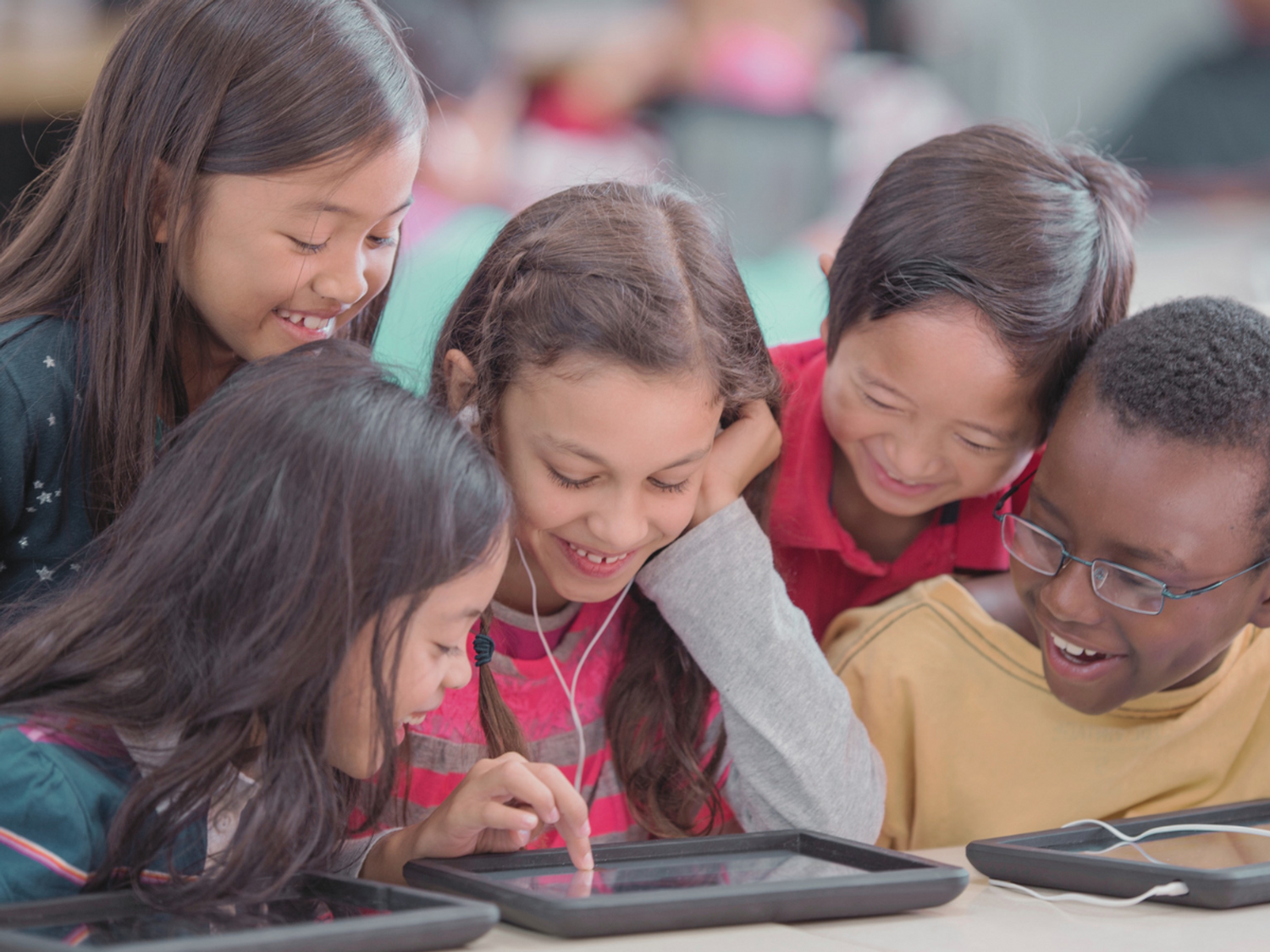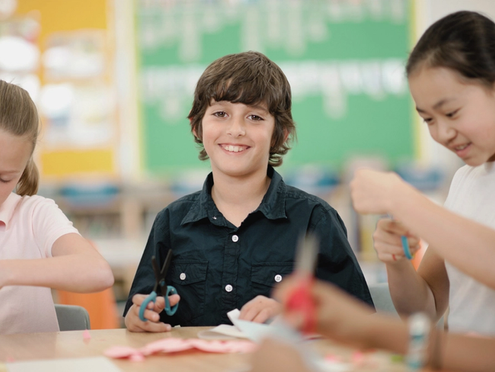So, how can gamification be used to enhance the learning experience of students in the classroom? In this blog, we explore some of the many benefits of utilising gameplay in the classroom.
What is gamification and why does it matter in education?
If you’ve ever earned points from shopping at the supermarket or moved up the leaderboard on a certain language app, then you have experienced gamification.
Gamification is the application of game-design elements and principles in a non-game situation. It is often used as a strategy for engagement across marketing campaigns, workplace training and productivity apps. It can also be a series of processes or activities to solve problems by applying the characteristics of game aspects e.g., in a classroom setting, a game of Hangman using words from the weekly spelling list.
Games and game-like elements have long been used to engage and educate. For example, the use of points, badges, scoreboards and gold stars to increase student motivation and drive progress. Used correctly, gameplay can make tricky elements of learning feel more fun, incentivising learners to engage with their learning.
At its core, gamification drives intrinsic motivation - this is the desire to do something because you have an interest in it, not because you have been told to do it. By encouraging intrinsic motivation, learners can take ownership of their progress, and teachers can spend less time encouraging learners to complete work.
The science behind gamification
It’s alarmingly easy to spend hours of time playing games online; it’s easy to get “hooked”. Digital gamification in education tries to harness the features of video games that get people “hooked”. It makes sense that similar levels of engagement are produced when these game-like elements are applied to learning tasks.
The science behind gamification revolves around a simple brain chemical called dopamine. Dopamine produces a pleasant feeling in the brain, making us feel satisfied. This chemical is produced when we do something that gives a “reward” factor - for example, a plate of delicious food, a jackpot on the slot machines, an amazing goal at a football game, or even going for a run.
Dopamine also helps encourage a feeling of ambition or drive - as dopamine is a pleasant emotion, people are likely to seek activities that promise an eventual dopamine hit.
And the reason why video games get humans so “hooked”? Dopamine.
By gamifying aspects of education, learners receive a feeling of achievement when they complete work, releasing a dopamine hit.
Furthermore, before you even receive the reward and the resulting dopamine hit, the dopamine neurons in the brain anticipate the rush you’re going to receive when you get your reward. Over time, these neurons learn when something pleasurable or satisfying is on its way and release dopamine even before the activity is complete.
Gamification works on the basis that the more tasks learners complete, the higher the reward will be, releasing dopamine - this makes it easier for learners to remain motivated in their learning (and it’s much more beneficial than playing on the PlayStation!)
What are the benefits of introducing gamification into the classroom?
Gamification in the classroom brings lots of benefits for teachers and students alike.
Increases levels of productivity and engagement
As fun as learning can be, very little is as fun for learners as a game. By incorporating teaching into gameplay, students find the process of learning fun, encouraging them to be more engaged with the subject material. This result can be achieved through non-digital means, such as a physical game in the classroom, or through gamified elements of digital learning.
Online gamified modules track users’ progress and create suitable challenges. As learners master something or complete a task, they receive recognition by being rewarded; this could be in the form of accruement of points, online money, unlocking something, moving up a leader board or creating something, to name a few. In the case of Bedrock Learning, learners earn Bedrock points, badges and entries into prize draws.
While it might not feel like traditional learning as they know it, every level learners pass and every completed challenge is a step forward in their learning journey.
Improves knowledge retention
Gamification helps students retain more of what they have learnt. Just like learning through play, gamification is a more memorable and interesting approach to learning through the enjoyment it evokes and the interactivity of the experience. This results in greater retention of the learning material. Making learning come to life is an important part of this increased retention rate.
Motivates learners through friendly competition
Friendly competition is healthy and can boost motivation - gamified learning helps to facilitate this in a healthy, low-stakes way.
Encourages teamwork and collaboration
Gamification provides learners with the opportunity to collaborate and communicate with other users through authentic interactions. This might be through giving feedback to other learners on something they have done, or by cooperating in working towards a group goal.
These interactions encourage a deeper level of engagement with the learning content. They also give learners a sense of being part of something bigger and the chance for collaborative problem-solving.
For example, Makers Empire 3D allows students to view other students’ designs from across the globe and give feedback. They can also design challenging mazes for others to try and collaborate on design task missions with learners from their own and other schools.
Enhances the learning experience
Gamification is a good way for students to connect their learning to real-world problems and applications in a risk-free setting. They can apply the knowledge and skills they have acquired, and reinforce these, through the gamification process. Learners can see how their choices within the game setting have consequences and rewards.
Research conducted by Nick Yee, (2006) found that in gamification, there were three motivating factors which lead to students’ resilience and overall enjoyment:
- Achievement: players want to excel and demonstrate mastery over the challenges of the game.
- Social factors: players are motivated by the relationships and team building involved in games.
- Immersion: players are motivated to discover new aspects of the game and create personal experiences through role-play and exploration.
Helps to measure performance
The inbuilt tracking that comes with most digital gamification tools, such as points, provides both teachers and students with insights into progress. Not only does this give teachers visibility of their students’ learning, but learners can take ownership of their achievements, encouraging self-motivation (and that wonderful dopamine hit!)
Gamification can measure performance and make progress visible by displaying:
- Points earned
- Progress bars
- Goals achieved (which can be personalised)
- Overview of learning content
- Leaderboard position
At a glance, students and teachers can view performance and the next steps required.
Instant feedback
When learners take part in digital gamified learning which requires them to answer questions as part of a task, the feedback is usually instant. They are notified that the answer is wrong, given a useful prompt and, if the answer is still not corrected, the incorrect answer is tracked for future teaching. If the answer is right, they are rewarded with points, moving on to the next level, etc. Learners don’t have to wait to see if they are doing well or what they need to improve on.
Makes failure acceptable
For learners in the classroom, failure can be a scary and even shameful concept. It often makes them adverse to taking the risk of ‘having a go’. On average, learners in the classroom say four words per lesson - largely, this is due to the fear of getting the wrong answer in front of their peers. With the dynamics of gamification, this fear is removed. Failing at something can often be part of the fun and learners remain motivated to have another go.
Huang et al (2013) found that gamification encourages students to fail and reattempt learning tasks without embarrassment. This persistence goes hand in hand with academic progress, and it also develops the grit and resilience learners need for adult life.
Supports cognitive development
Digital gamified learning leverages the benefits of video games in that it gives learners:
- Improved spatial awareness
- Increased attention span
- Improved ability to visualise objects from other points of view
A 2013 study by Blumberg & Fisch found that games that invite critical thinking and problem-solving can improve students’ processing and information retention abilities. Much digital gamified learning can be categorised in this way.
Beyond these benefits of gamification, there are many more pros and cons of game-based learning that you can read about here.
Putting it into practice
Putting gamification into practice in your classroom doesn’t have to be overly complicated or elaborate.
Identify your learning objectives
Certain learning objectives will lend themselves to gamification more than others. The success of implementing gamification also depends on the dynamics of your class and how you think they would receive it - would it be motivating or distracting?
There seems to be a ‘lean’ towards using gamification for maths-based learning. The rapid recall of number facts learners need to solve complex maths problems often benefits from being ‘gamified’.
However, gamification can be used in other subjects too. The gamification elements of Bedrock Learning encourage learners’ self-motivation when improving their literacy, leading to increased attainment.
Introduce gamification
You can ‘gamify’ lessons or activities you already have by adding one or some of the following elements:
Point systems
Points can be used to reward learners when they complete work, win competitions or achieve milestones. For further motivation, learners’ points could enter them into a prize draw or competition, or be featured on a leaderboard.
Read more about Bedrock points.
Badges and rewards
Rewards and badges can be awarded to learners who master a particular topic or skill. These are visible symbols of their success and their progress, reminding learners of the results of their hard work - this can help to maintain their motivation long-term.
Create a leaderboard
Leaderboards are a great way to introduce low-stakes, healthy competition into the classroom without causing anxiety or fear of failure. Learners are rewarded for the time they spend doing work - this is even more effective if points are awarded even for unsuccessful attempts, as learners are incentivised to keep trying and develop resilience.
Most importantly, leaderboards show learners that hard work can be done - learners at the top of the leaderboard act as proof for others that success and achievement are possible and attainable for everyone.
How Bedrock uses gamification to improve literacy
Gamification forms the foundation of how independent learning is encouraged on Bedrock. Bedrock’s points system, as well as badges for completing topics, supports learners to make continuous progress and rewards success.
In addition to this, activities within the digital curriculum are formulated to mimic games, such as drafting text messages, putting synonyms and antonyms into the bin, and speed rounds.
These features are carefully crafted and selected to motivate learners on Bedrock, whether completing it at home or in the classroom.



